Paintings to Know
Birth of Venus, Botticelli, 1484-6
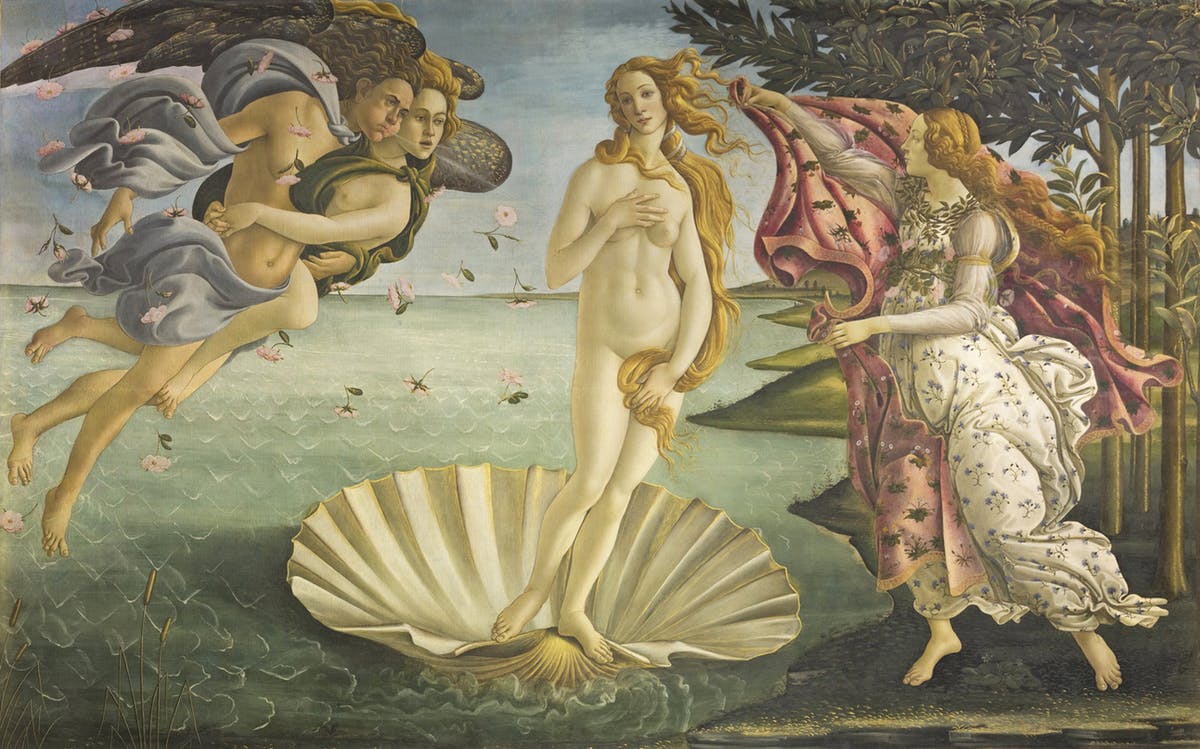
- Venus was born from the sea when Uranus’s testicles got cut off, fell into the ocean, and impregnated the sea foam. Venus was formed out of the sea foam.
- Man to the left is Zephyr, god of gentle wind, who falls in love with and abducts the nymph Chloris (who later becomes Flora after being wed to Zephyr)
- Venus is always depicted as being naked or in some act of love or sex
- Other attributes include doves, a gold ball, Cupid (her son), and sea shells or some indication of the sea
- Zephyr’s attributes are Flora/Chloris, and a gentle wind
Primavera, Botticelli, 1482
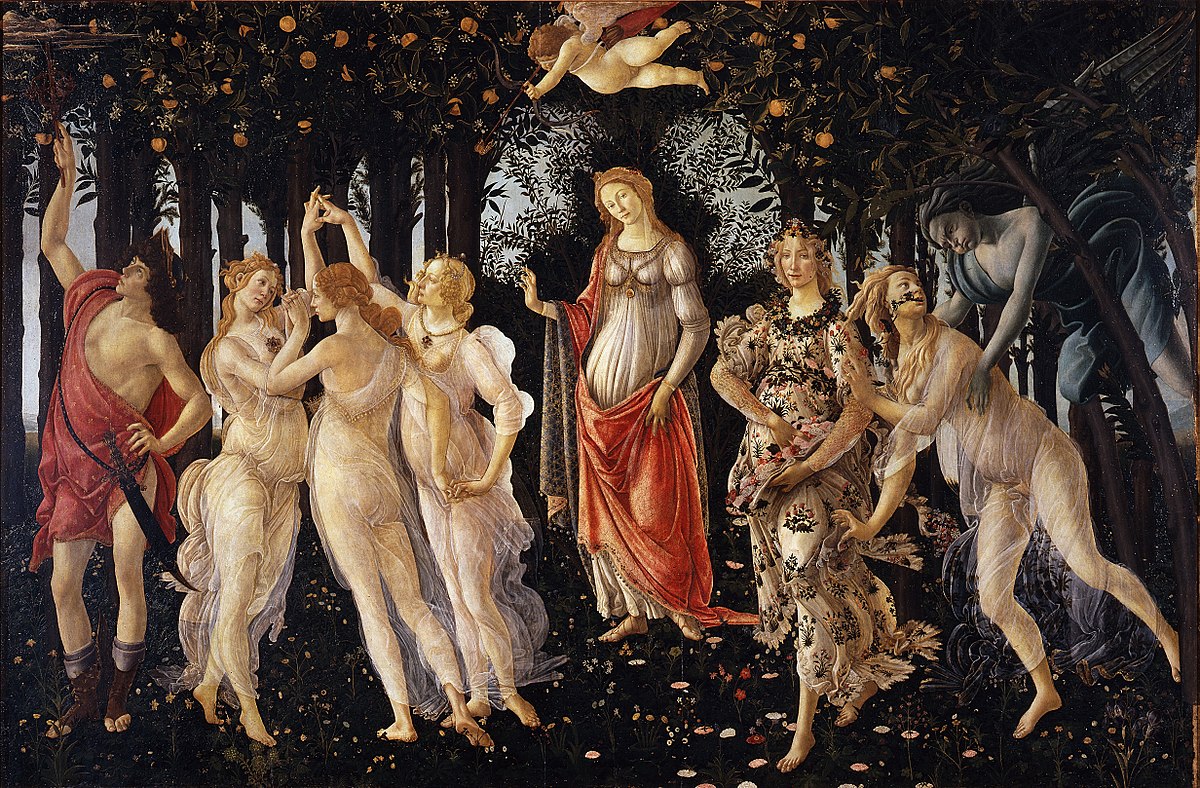
- Venus depicted in the middle
- To the left, three graces
- Three graces are always depicted together with little or no clothing, and one always has her back to us, sensual, golden balls (story), they are friends of Venus/Aphrodite, slouched, touching each other.
- To the left, three graces
- Zephyr is to the right abducting Chloris, and the woman next to Choloris is Flora, after the marriage has taken place (continuous narrative)
- Cupid is above Venus
Venus and Mars, Botticelli, 1485
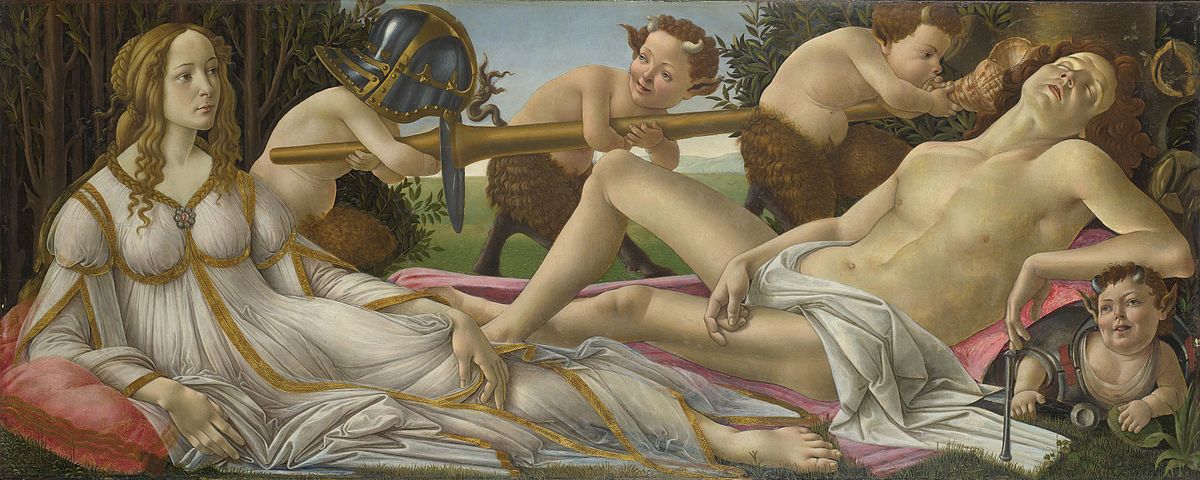
- Venus (left) and Mars (right) depicted with children satyrs and bees
- Venus has distinct facial features
- “Presents an image of beauty that is still astonishingly potent”
- Flawless complexion
- Regularity of features
- Smooth contours of face
- The idealized form of beauty, not just an individual
- Venus has distinct facial features
- Bees are an indication of the family who commissioned the painting
- Believed that the family was the Vespucci, which roughly translated to the plural for small wasps.
- The other creatures in the image are satyrs, which can be depicted at any age
- Venus’/Aphrodite’s attribute of the sea is barely visible in the background.
- Mars’/Ares’ attributes of his armor are visible scattered around him.
- This painting can be read as the message that “love conquers war” or, more broadly as “love conquers all” (although for my money, that’s reading it a little too broadly).
The Ambassadors, Hans Holbein, 1533
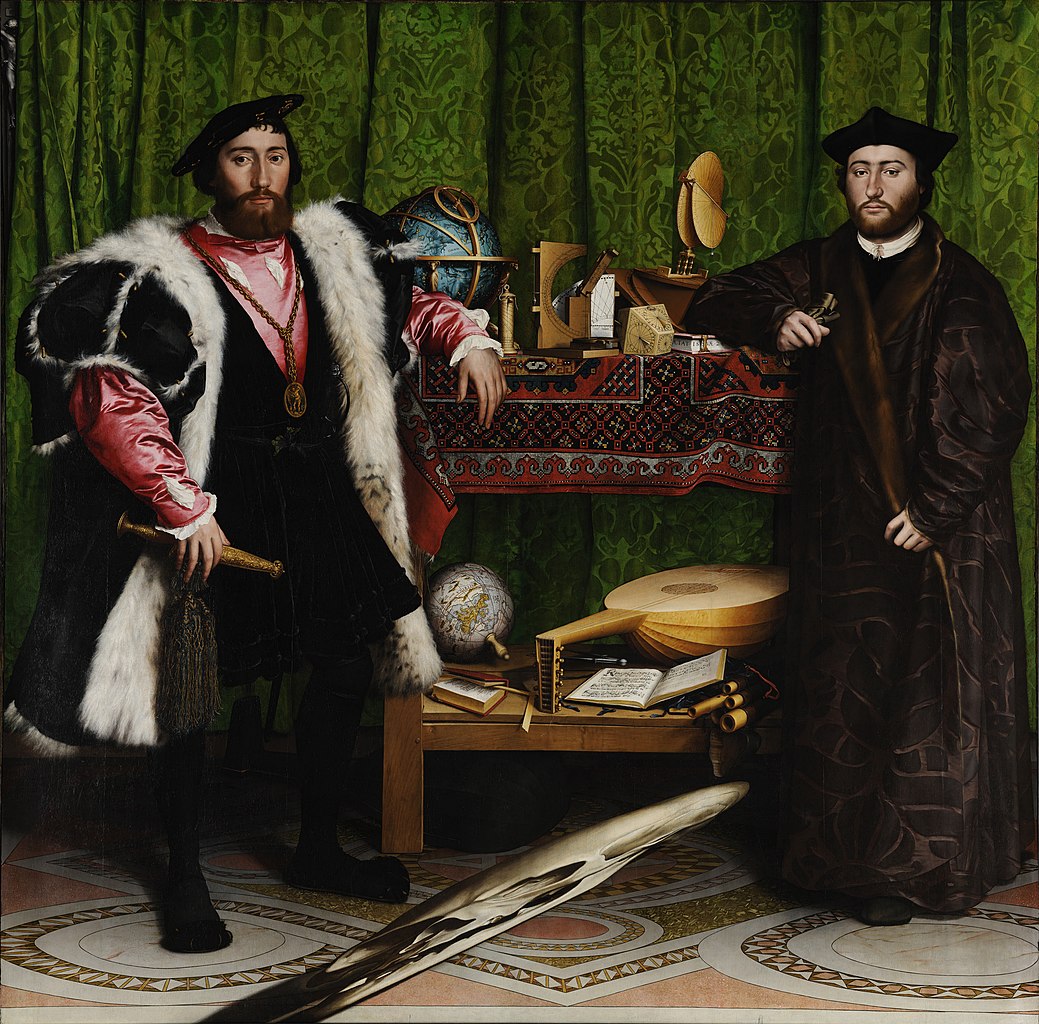
- Sitters are wealthy, therefore not explorers
- They are Diplomats or ambassadors
- Done by a German painter who came to England and served as the court painter for Henry VIII
- They were ambassadors sent to England to reason with Henry to not leave the Catholic church
- French Ambassador on the left (Jean de Dinteville)
- Name and age are inscribed on the dagger on his waist
- Vatican Ambassador on the right (Georges de Selve)
- Name and age are inscribed on the book
- Can be determined by the style of clothes he wears, the clothing associated with the catholic church (he is a priest. His hat is a clerical/priestly hat. Bishops have mitres [the pointy things])
- Painting is both a portrait and an allegory
- The broken lute symbolizes the discord that would happen if Henry breaks from the Catholic Church
- Contains an anamorphic image of the skull: when an artist purposefully distorts an image, which is only seen whole from a certain perspective
- Image contains what will happen if Henry leaves the Catholic church
- The poses are contrasting to one another
- Jean on left is open and expansive, shown with feet apart, broad shoulders, and hands placed openly
- Georges on the right appears more cautious, stands slightly further back, hands are clenched and pulls his coat around his body
- Shows the difference between the knight and the cleric
- Demonstrates personality
The Virgin of the Rocks, Leonardo, 1495-1508
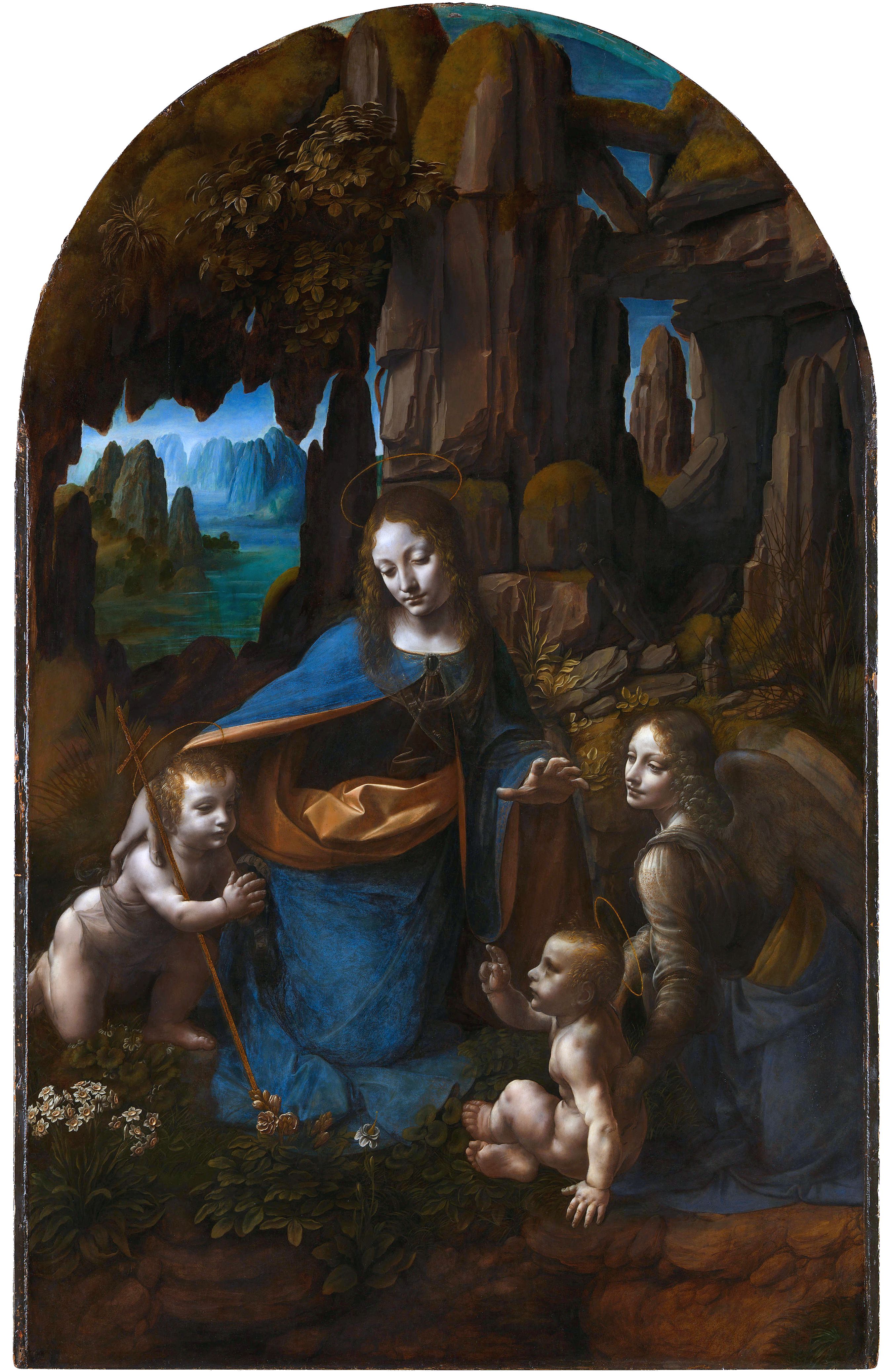
- Look at the left hand corner of the painting, where there are the mountains.
- The mountains are all actually the same size, but there is a type of forced perspective by “painting the air” as Da Vinci stated
- Aerial perspective is painting things that are further back blue
- The people in the image whom we need to know are Mary (a.k.a. the Madonna), Jesus (on the right, identified by the fact that he is giving a blessing), and John the Baptist (the child receiving the blessing)
- Background inspired by the fabled meeting of the two cousins within the wilderness during the flight into Egypt
- The staff in JtB’s hand was added later by a conservationist who thought it belonged there
- The one hanging in the National Gallery was likely not done by da Vinci but by his apprentices in his workshop; the one in the Louvre is da Vinci’s.
The Embarkation of the Queen of Sheba, Claude Lorraine, 1533
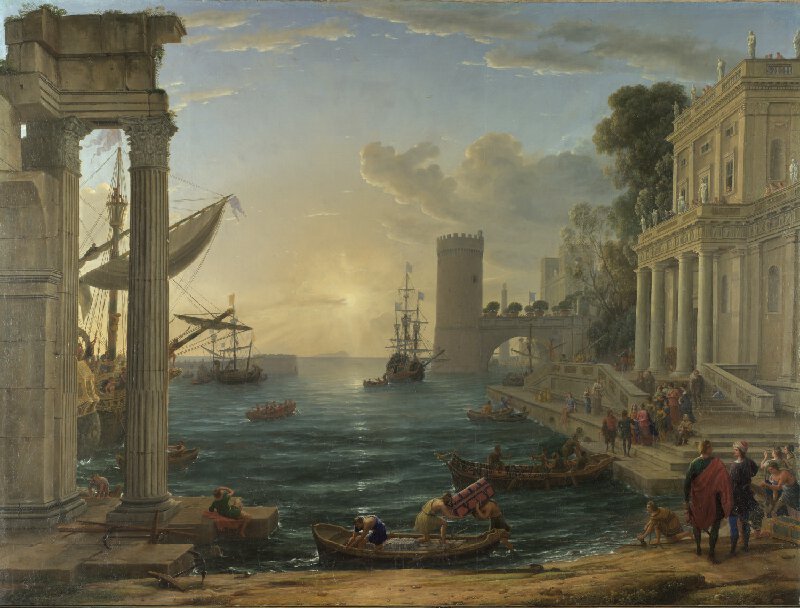
- Telling a story from mythology but is classified as a landscape because the people are not the primary focus.
- Shows depth, not perspective
- Turner requested his painting be displayed next to this one
- Contrast between the light and dark, emphasizes the dazzling quality of the water
Irises, Claude Monet, 1914-17
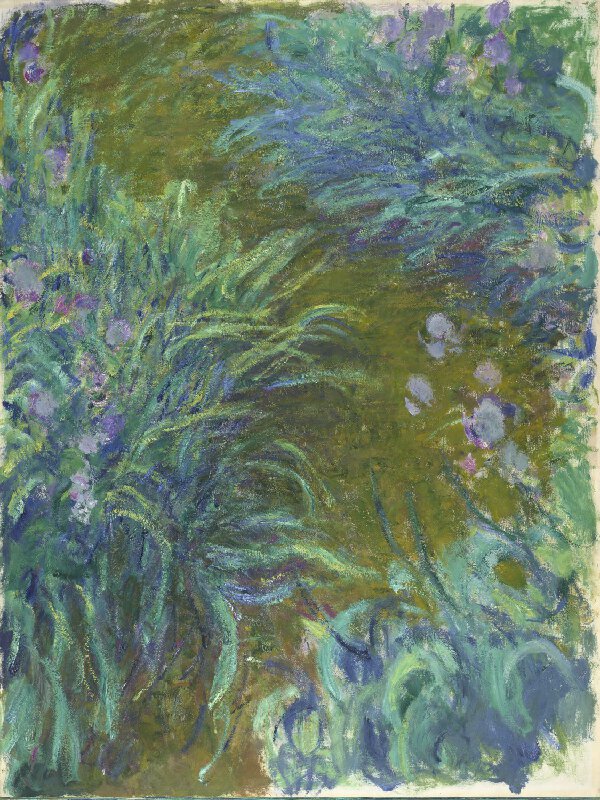
- Zoomed in on water lilies
- Unfinished painting
- Layers of color
- Uses a pallet knife to smear paint onto the canvas
- Refused to use black in landscapes because black is not a natural color (i.e. it does not appear in nature)
Christ and St. Peter, Perugino, 1481
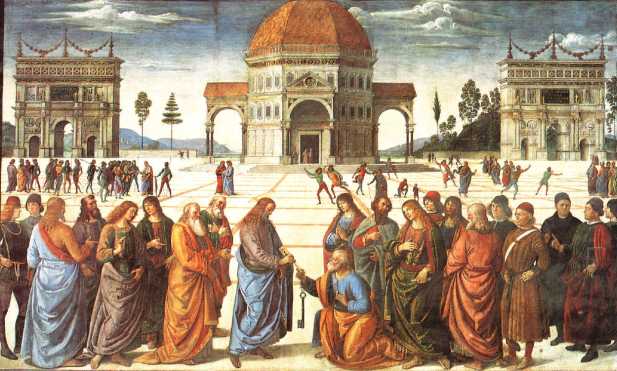
- Christ is seen here with St. Peter giving him the Keys to the Kingdom
- Important note on technique
- Use of perspective, distance, and scale
- Uses aerial perspective (mountains in blue in the background)
- Uses mathematical perspective, perfect scale for distance
- Use of perspective, distance, and scale
St. Sebastian the Martyr, Antonio del Pollaiuolo and Piero del Pollaiuolo, 1475
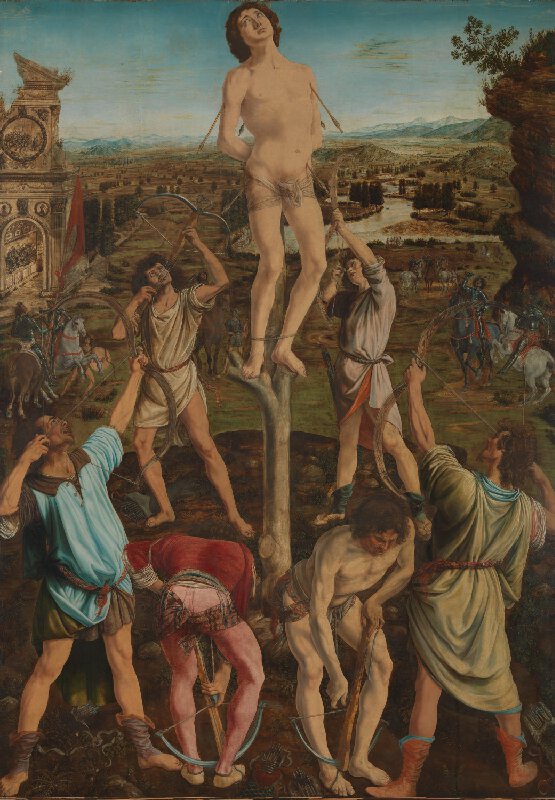
- St. Sebastian died full of arrows
- Needs arrows or a bow as attribute, but doesn’t always appear depicted as being shot
- Contorted red face of the archers depicts the vicious nature of the archer and the straining concentration of his task
- Uses aerial perspective
Bacchus and Ariadne, Titian, 1522-3
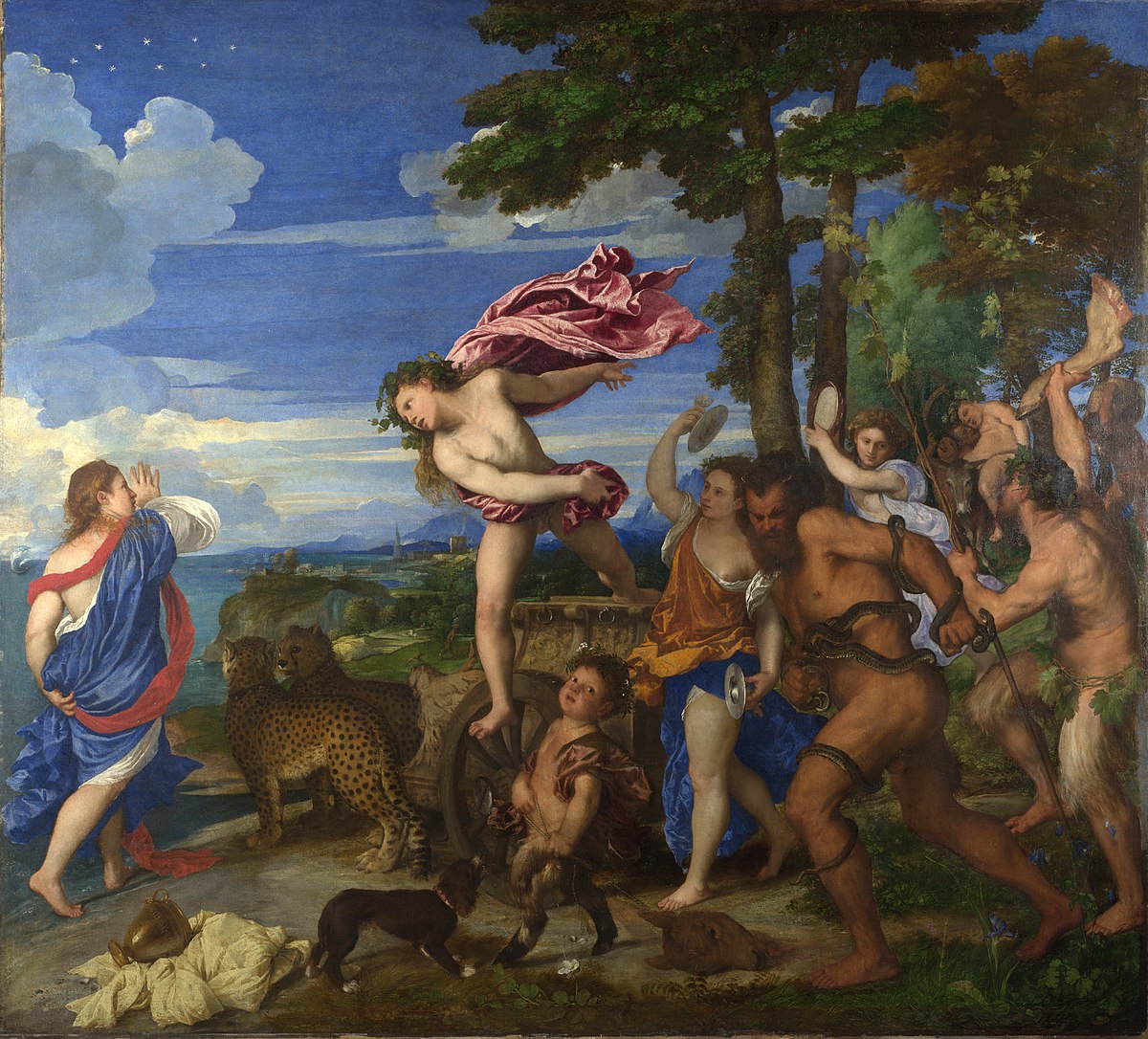
- According to the allegory, Bacchus, god of wine, falls in love with Ariadne on sight after her prior lover Theseus sails away. Theseus is the slayer of the Minotaur in the Labyrinth. Ariadne fell in love with Theseus and gave him a sword and ball of string to help him kill the Minotaur. In exchange, she wanted Theseus to marry her on his return. When he abandoned her on Naxos, Bacchus rolls up with his squad of rowdy drunkards (one of his attributes) and professes love to her (“behold a more faithful lover”) by making her into a constellation, symbolized by the stars above her head.
- In mythology paintings if it is a specific story there is no way to identify it specifically unless you know the myth
Sleeping Venus, Titian, c.1530
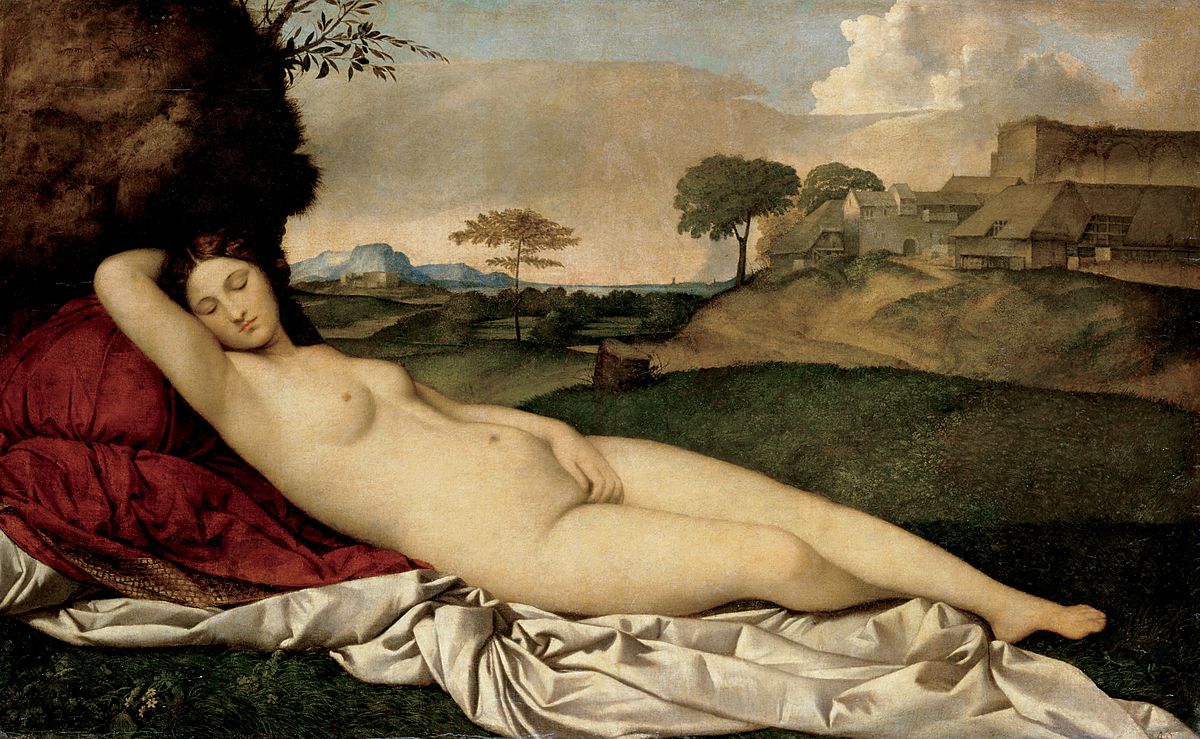
- Attributes of Venus in this painting are that she is naked
- Can also say that she “looks like Venus” because Botticelli’s paintings gave us a pretty good idea of what she “looks like”
- Can’t be a portrait because at the time it would have been improper to portray a nude woman outside
Venus of Urbino, Titian, 1530s
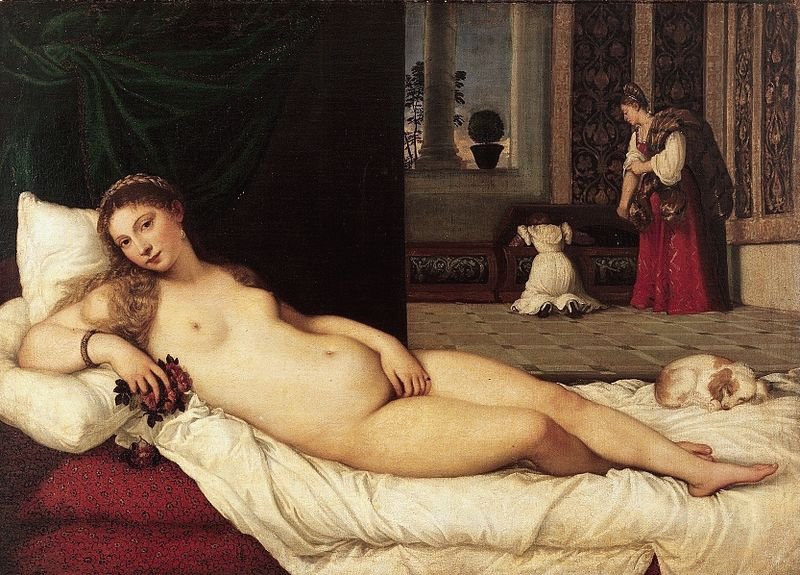
- Falsely identified as a Venus.
- The lover of the Duke of Urbino - we know because it was in his study behind a curtain.
- She’s also awake and looking at us, indicating she may be a “real” person.
Rain, Steam, and Speed, J.M.W. Turner (a.k.a. bae), 1844
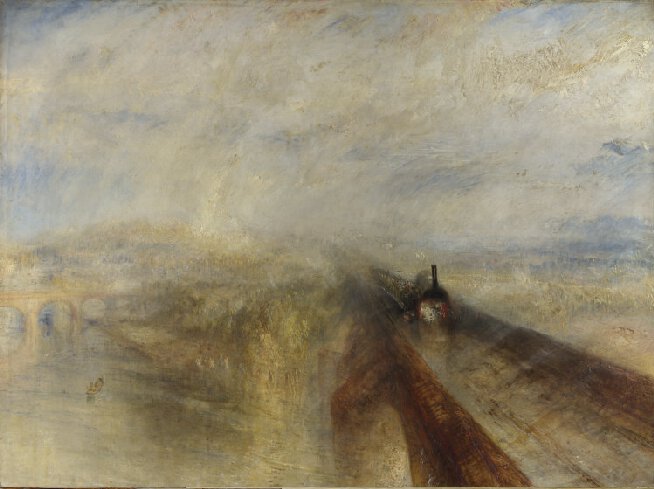
- People used to stop and watch trains
- Turner is not considered an impressionist
- Used repoussoir
- The illusion of the train rushing forward is an added element to the technique of repoissior
- In order to emphasize the speed of the train there is a hare painted on the track ahead of the train
Arnolfini Portrait, Van Eyck, 1434
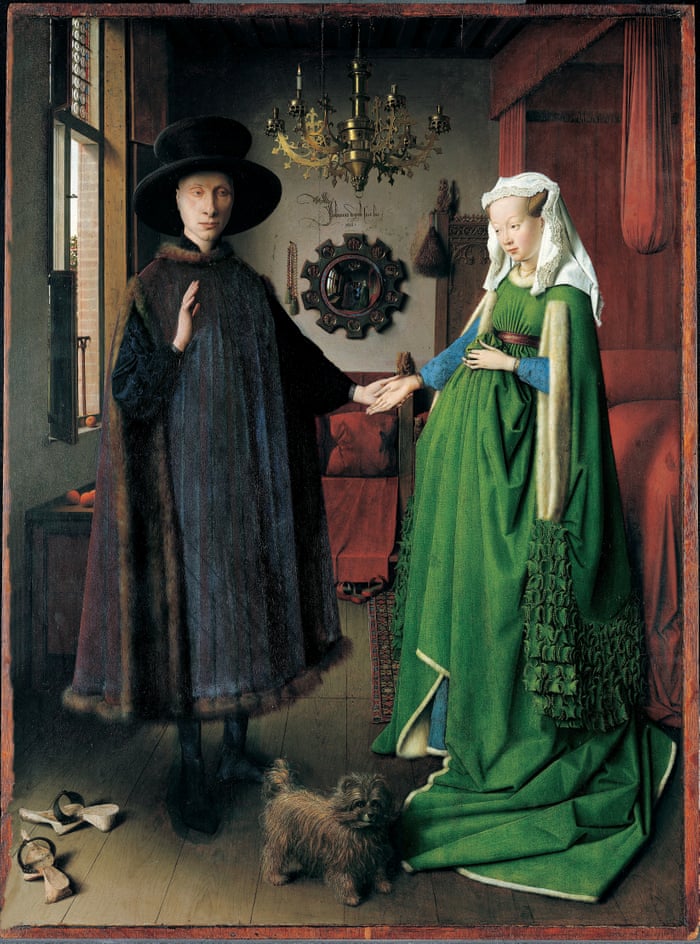
- There is a small statue of St. Margaret, the patron saint of fertility
- Pose of the is theoretically an indication of wealth, given the amount and type of fabric, also holding it above the floor to protect the fabric
- Some speculation that she is pregnant but not confirmed
- The mirror in the background is surrounded by images of Christ
- Within the mirror it shows the rest of the people in the painting, those who are doing the painting/a religious individual (4 people total, not including dog)
- Possible marriage ceremony
Long Grass with Butterflies, Vincent van Gogh (a.k.a. also bae), 1889-90
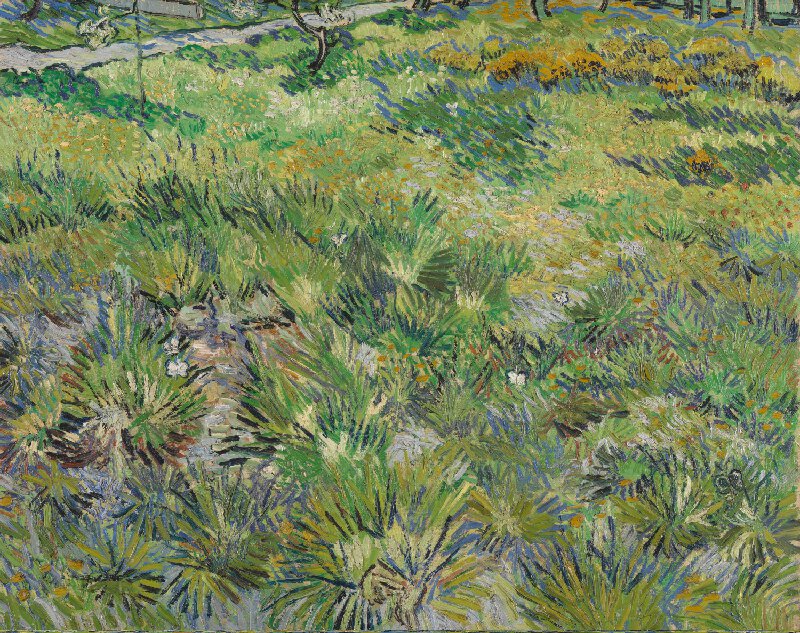
- Uses landscapes to evoke emotion or convey feelings
- Large use of black - takes the audience aback because black is not a natural color
- Harsh lines
- One of the last paintings he did before he died by suicide
- Was the courtyard of the asylum he lived in
Topics From Class
Conservation and Restoration
Conservation = preserving the artwork as we receive it or have it today
Restoration = trying to restore the painting or artwork to its original state
Fresco was done by painting into wet plaster that was put on top of dry plaster with compositional sketches on it - the paint dried with the second layer of wet plaster and bonded more durably with the plaster. This is why we still have a lot of Renaissance frescoes. After the bulk of the plaster dried, the artist would add details like eyes and faces into the fresco by painting in a “secco” manner.
Secco, by contrast, was done by artists painting right on to the dry plaster. This caused it to flake off relatively easily and quickly. More frescoes survive from the 1200-1600 time period than seccos from the next period. But after 1600, artists began to wonder if it was worth all the work. Clearly, it wasn’t.
More recent paintings use varnish, transparent, translucent layer added to paintings to highlight color and protect painting. Modern-day acrylic paintings tend not to use varnish because it’s unnecessary and adds sheen that most artists don’t really want on their paintings.
Original varnishes were made out of amber or egg white, which causes the painting to discolor over time (amber turns orange/sepia, egg white turns yellow/jaundiced). This creates an interesting dilemma for conservationists: do we remove the discolored varnish and risk damaging the painting to show the “true color,” or leave what we have now?
National Gallery historically has been lambasted for “ruining” paintings by removing varnish. Case study: The Battle of San Romano by Paolo Uccello. The cleaning solution the Gallery used removed the top layer of paint and varnish and with it all shading in Uccello’s painting as they were trying to restore it, so the painting just looks dumb now.
There are a few other important conservation gaffes to know:
- Santa Croce: Giotto’s Bodi Chapel: 1700’s, Giotto’s frescoes were whitewashed over and tombs put up. When medieval things became vogue again in the 1800’s, the whitewash and wall tomb was removed, but part of the fresco came with it. In the 1900’s that paint was added back in, but 50 years later, it was removed.
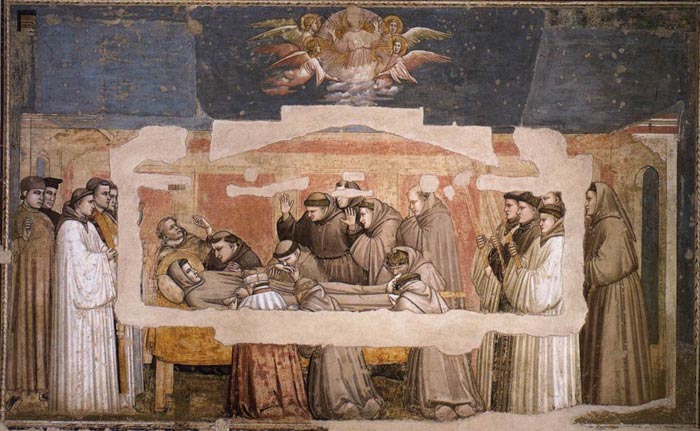
- Leonardo’s Last Supper: The church with the Last Supper painting was largely destroyed WWII, except the last Supper wall; in the 1980’s, it was decided to conserve Leonardo’s fresco. Leonardo painted 5 frescoes that we know of, and all but this have disappeared, because from the 1500’s onward, the fresco was conserved as it started to fade. As the conservationists stripped down to try and find Leonardo’s base layer, they realized it didn’t exist, that it had also faded over time. So the conservationists repainted the entire thing to hide the story.
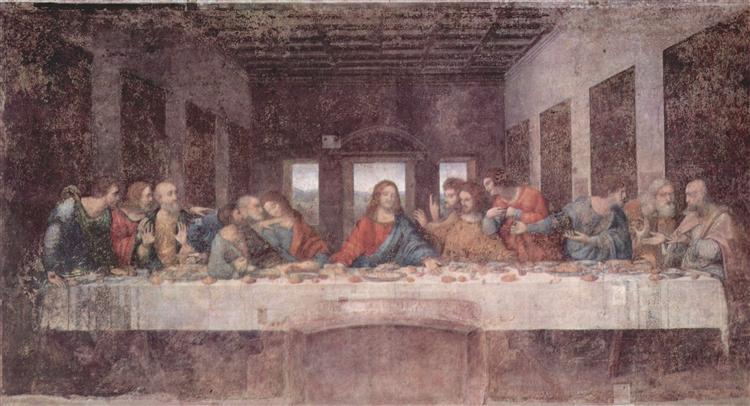
- Sistine Chapel: The conservationists removed shadows and shading along the ceiling because “Michelangelo wouldn’t have painted in secco.” When they realized he would, they were about half-way done with the vault (ceiling), so they just finished removing the shadows and shading throughout the entire chapel. The whole thing now looks a little Disney.
Michelangelo sketches reveal that he intended to use shadows.
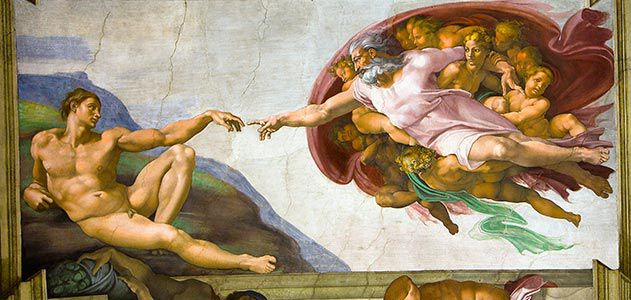
- Adam and Eve: Masolino and Masaccio’s Adam and Eve painting was restored, arts of the bodies were missing. Restorers chose to interpret Adam and Eve as without genital coverings. This Adam and Eve is now the only Adam and Eve without coverings.
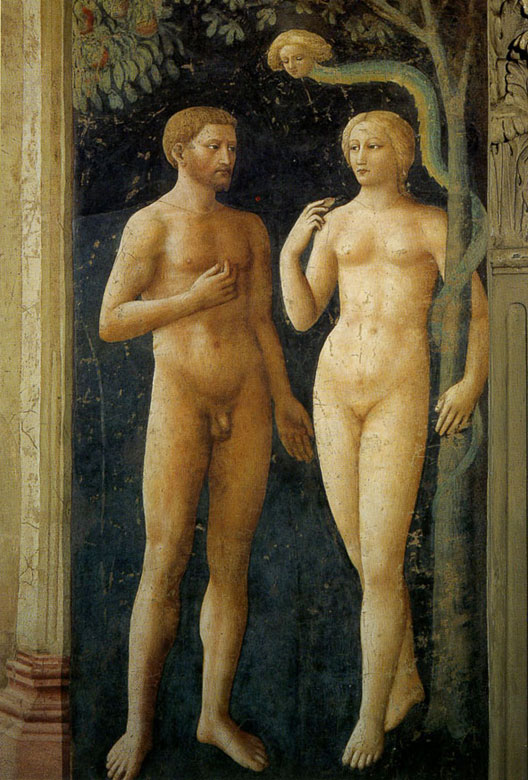
The Art Market
The art market is all about taste; if a piece is fashionable, it goes up in price. Example: van Gogh’s paintings were worth probably literal dirt when he was alive, but now, if you were to try to pay for a van Gogh painting with dirt, it would be like, an absurd amount of dirt. Nothing’s changed about the paintings, but demand has gone up, and so has the volume of dirt.
The art market is completely non-competitive. That is, there are no substitute goods for a Leonardo, it’s just not how a market based off of unique objects works. Art by dead artists tends to be worth more because there won’t be any more produced, unlike living artists whose finite number of paintings hasn’t yet been established.
Attribution is achieved by connoisseurship. It is the labeling of an artist as the creator of an artwork, hopefully correctly. However, it doesn’t always go quite that smoothly:
- Modigliani farce: a few students and an artist sank fake Modigliani heads into a river where there were plans to search for art. The three heads were found and the art community quickly identified them as genuine Modigliani pieces. Eventually the students and the artist came forward. Twas a massive embarrassment for the connoisseurship community.
Art Education
Historically, there were two traditional places of learning for artwork.
Workshops were practically the only way of teaching artists up until about the 1600s. Inside of workshops, young boys would be apprenticed to a master painter at an early age - they would get food, lodging, and an trade education while the master would get a minion. The boys would learn to emulate the master’s style and, if they got good enough, could strike out on their own and start their own workshop and do their own work.
Academies were schools of art. There were many teachers, and students could go to different teachers to learn different things. This allowed for more diverse learning and artistic style as the student has freedom to discover their own specialty and style. The first academy was opened in 1531 in Rome by Baccio Bandinelli. In the school, artists engaged in a reciprocal relationship with the medical community where doctoral students would dissect models for the artists to draw anatomically, and the artists would produce anatomical renderings of the models (see section on anatomy and art education).
In 1563, Visari opened a second academy, the Accademia del Disegno in Florence, publicly funded by the Medici family and other politicians. The Academia had a three-year cirriculum:
- Just drawing
- Students choose a specification
- Completion of training Students also studied mathematical perspective and other “good shit”.
Other important dates:
- 1591 - Academy of St. Luke opened in Rome, and it’s still open today.
- 1768 - Royal Academy, first academy opened in London by Sir John Reynolds. Reynolds wanted more diverse art (because only portrait and landscape had been allowed or done since Henry VIII, the bastard) and more democratic training for artists. In the Royal Academy, artists could paint whatever they wanted! To encourage the public to buy allegory and religious paintings, Reynolds held exhibitions of paintings done by third-years.
History Paintings was a genre of paintings developed by Reynolds. The idea was to depict, with “historical” accuracy, things that had happened in contemporary history, literature, art, etc. Some new, non-iconographic religious art could be created! They weren’t fit for church though (I mean, same, really). We also got some neat pics of Shakespearean plays and stuff.
Anatomy and Art Education
Leonardo believed that artists first had to understand anatomy to be able to accurately portray bodies in motion or poses. He and many other artists did some (arguably dodgy) dissections on exhumed bodies until the 1530s, then that had to stop. Some artists went to see public executions, such as at the gallows, to see what bodies looked like without doin’ the illegal.
In 1543, the first anatomy textbook was published. Students of medicine watched as doctors dissected medical subjects. Artists came and drew as it happened. This was a mutually benificial relationship: artists got to have subjects for their paintings without skirting the law, and medicine students and teachers got artistic renderings of their work for new textbooks and teaching materials. Useful to know: an Ecorche is a model of a body with no skin. Helps to understand muscles and how they work.
By the 17th Century, this practice largely faded away. Medicine no longer needed artists to reproduce their anatomical drawings, and artists didn’t really need to go to see dissections with the advent of better models. Plus, artists were specialising instead of just blanket drawing, so not everyone needed those skills. Artists still, from time to time, prepared models and ecorches for the medical profession and for their own reference.
Women in Art Education
Pretty dismal representation of women, historically and today. By the 1800s, women started to be allowed in art courses in London, but their education was separated from their male colleagues. In 1879, women were allowed to draw from female nude models. It wasn’t until post-WW2 that women and men were doing the same work in the same room, largely without restriction.